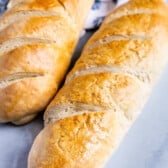Easy French Bread Recipe
This is the BEST Homemade French Bread recipe! It makes two loaves of crusty and soft french bread and is the perfect side dish for any meal.
Servings: 20 servings
Calories: 121kcal
Cost: $5
Ingredients
- 4 ½ - 5 cups (558-620g) all-purpose flour divided
- 2 packets Fleischman’s Yeast Rapid Rise Yeast or any instant yeast (4 1/2 teaspoons)
- 2 teaspoons salt
- 1 ¾ cups (414ml) water
- 1 tablespoon olive oil
- 1 egg white
Instructions
- Add 1 cup of flour to the bowl of a stand mixer fitted with the dough hook. Add yeast and salt and whisk to combine.
- Place water in a heat-proof measuring cup. Heat for about one minute (maybe longer, it depends on your microwave) until water is between 120°-130°F. It’s best to check this with an instant-read thermometer, but if you don’t have one, think hot bath water. Add oil to water, then pour into dry ingredients.
- Run mixer with dough hook, scraping the sides of the bowl, just until the flour is all moistened. Add 2 more cups of flour, mix, then add an another 1 1/2 cups of flour and let the mixer run until the dough is thick and starts to come together, adding an additional 1/2 cup flour as needed. It won’t form a ball but will only be slightly sticky to the touch.
- Turn dough out onto a floured surface and knead until the dough forms a ball and is elastic and springs back when pressed with two fingers; cover and let rest 10 minutes.
- After 10 minutes, divide the dough into two equal pieces. Roll each piece of dough into an approximate 12x15-inch rectangle (no need to be exact) and roll it up from the long side. Pinch the ends to form the pointy ends of the loaf.
- Place loaves on a cookie sheet covered with a silicone baking mat or parchment paper. Cover and let rise until double in size, about 45 minutes.
- Preheat oven to 400°F.
- Uncover loaves and use a sharp knife to score 4-5 times on top to create the French bread look. Brush the dough lightly with egg wash.
- Bake for 20-25 minutes or until the loaves are golden and hard and sound hollow if knocked on. To make a browner and crunchier crust, as shown in the photos, do a second brushing with egg white after 15 minutes of baking.
- Cool slightly before serving, store in an airtight container for up to 3 days.
Video
Notes
This recipe is adapted from BreadWorld.com, where they used active dry yeast. If you have only active dry yeast, do the following:
- Place water in the bowl of a stand mixer. Sprinkle in yeast; stir until dissolved. Add oil, salt and enough flour to make a soft dough, mixing with the dough hook. Knead on floured surface until smooth and elastic, about six to eight minutes. Place in greased bowl, turning to grease top. Cover; let rise in warm draft free place until doubled in size, about 30 to 45 minutes.
- Punch dough down. On floured surface, divide dough in half; roll to 15x10-inch ovals. Roll up from long ends to make loaves. Pinch seams and ends to seal; taper ends. Cover; let rise in warm draft free place until doubled in size, about 30 to 45 minutes. Bake as directed.
- For a crusty golden loaf, do a second egg wash halfway through baking.
- You know your bread is done when it's a beautiful golden color.
- How to Store French Bread: Store this in an airtight container or bag for up to 2 days. Because there are no preservatives in this bread it will get stale and go moldy after a couple of days.
- Can you Freeze French Bread? Yes! You can freeze the freshly baked loaf - just let it cool first then wrap it with plastic wrap and freeze for up to 2 months.
Nutrition
Serving: 1serving | Calories: 121kcal | Carbohydrates: 24g | Protein: 3g | Fat: 1g | Saturated Fat: 1g | Sodium: 237mg | Potassium: 36mg | Fiber: 1g | Sugar: 1g | Calcium: 5mg | Iron: 1mg
